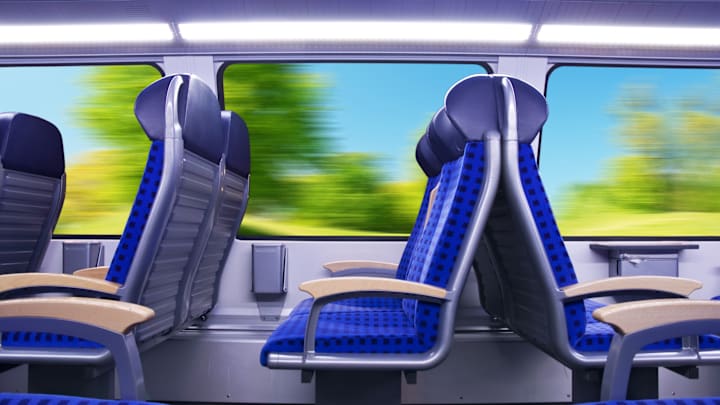With the notable exception of rollercoasters, railed vehicles—from Amtrak’s California Zephyr to Japan’s Shinkansen bullet trains—don’t come with built-in seat belts. And yet, every time there’s a major train accident, newspaper headlines ask the same question: Why not?
After all, most other high-speed vehicles have seat belts. In cars, they reduce front seat passengers’s deaths by 45 percent and critical injuries by 50 percent, according to the National Safety Council, and have saved an estimated 374,276 lives between 1975 and 2017 in the U.S. alone. Airplanes have seat belts for safety, too; they are the most effective way to prevent passenger injuries caused by turbulence.
But just because seat belts make cars and planes safer doesn’t mean they’d do the same for trains, which are built differently, move differently, and, most importantly, seat their passengers differently.
Fortunately, Train Accidents Are Rare
Studies into the potential effects of installing seat belts on trains have concluded that the disadvantages outnumber the advantages.
First and foremost, researchers have found the risks of traveling by train are simply too low to make installing seat belts a worthwhile investment. Though accidents like the 2015 Philadelphia train derailment, which killed eight people and injured 200 more, are tragic, they are also a statistical rarity.
You May Also Like:
- That Extra Loop of Fabric on Your Seat Belt Is Actually an Important Safety Feature
- This Train Trip Hits Every Corner of America in a Week for Less Than $1000
- The Train Crash That Spooked Charles Dickens
Add Mental Floss as a preferred news source!
The number of car-related deaths is thought to be 10 times greater than the number of public transport-related deaths, which includes not just trains, but also buses, trams, subways, and other conveyances. The contrast is even greater for injuries: in 2023, there were an estimated 6542 railroad-related injuries in the U.S., while the National Highway Traffic Safety Administration reported the number of non-fatal roadway accidents reached 2.44 million. With data like this, transportation safety expert Steven Harrod told The New York Times in 2015, seat belts on trains “would not add a statistically relevant level of protection.”
Installing seat belts on trains would also be impractical. As The New York Times explained, the simplest and cheapest option, the two-point lap belt used on airplanes, would not adequately protect passengers on trains, which move side to side as well as forward and backward. The safer three-point seat belt, like those in most cars, cannot easily be fitted to existing train seats, so the whole interior infrastructure of a train car would need to be replaced.

There are other impracticalities worth considering. Many trains are designed to have standing room for passengers, meaning there’s no way to provide seat belts for every passenger without significantly reducing their carrying capacity. But even if seat belts were to be installed from the first to last car, there is no straightforward way to make sure that passengers actually use them. Trains may also be delayed as passengers take extra time to unbuckle.
A Safety Measure that Doesn’t Measure Up
Last but not least, seat belts might actually make traveling by train more dangerous—not less. If trains were retrofitted with stiffer seats and seat belts, a report from the Transportation Research Board of the National Academies published in 2007 warned, passengers who aren’t wearing seat belts could “become projectiles” and crash into the seats in front of them, as well as passengers who are wearing seat belts. A report from the UK Rail Safety and Standards Board reached a similar conclusion, predicting that stiff seats and seat belts, while reducing the risk of injury for those who used them, would actually increase the risk for those who didn’t.
There are more reliable ways to improve the safety of trains. Instead of seat belts, experts argue, companies and governments should invest in technologies like Positive Train Control and Advanced Obstacle Detection, which are automated systems that monitor traffic and track conditions. They say the best way to keep trains safe is to focus on what’s happening outside the train, rather than inside.
